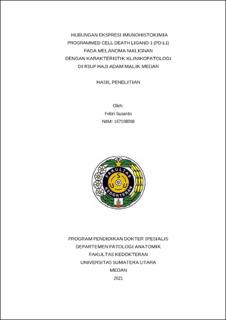Hubungan Ekspresi Imunohistokimia Programmed Cell Death Ligand-1 (PD-L1) pada Melanoma Malignan dengan Karakteristik Klinikopatologi di RSUP Haji Adam Malik Medan
An Immunohistochemical Study of the Relationship Between Programmed Cell Death Ligand-1 (PDL-1) and Clinicopathological Characteristics of Malignant Melanoma in General Hospital Haji Adam Malik Medan

Date
2022Author
Susanto, Febri
Advisor(s)
Alferraly, T. Ibnu
Delyuzar
Metadata
Show full item recordAbstract
Malignant melanoma is a potentially aggressive and
lethal malignancy deriving from melanocytic cells. Although it
comprises only 3% of all cutaneous malignancies diagnosed each
year, malignant melanoma contributes to 75% of all skin cancer
deaths. In the last decades, there have been advances in immune
checkpoint inhibitor (ICPI) development in treating melanoma
metastases. ICPI such as programmed cell death ligand-1 (PD
L1) is primary membrane-bound protein expressed in dendritic
cells and monocytes. Programmed cell death protein- 1 (PD-1)
inhibitors or PD-L1 inhibitors will clinically improve treatment
response and overall survival rates in many types of tumors.
Nowadays, PD-L1 is being intensively used in cancer patient
management revolution, especially in melanoma and non small
cell lung cancer. Therefore, the researchers were interested in
assessing the relationship between PD-L1 immunohistochemical
expression and clinicopathology of malignant melanoma patients
in General Hospital Haji Adam Malik Medan. Objective: To
analyse the relationship between PD-L1 immunohistochemical
expression and clinicopathology characteristics of malignant
melanoma in General Hospital Haji Adam Malik Medan.
Materials and Methods: A cross-sectional analytic study was
performed using formalin-fixed tissue paraffin blocks from 18
skin cancer patients histopathologically diagnosed as malignant
melanoma. Clinical data of patients (age, gender, tumor location)
was acquired from medical record. Each slide was double blindly
reevaluated by researcher and two pathologist. Tumor depth,
tumor invasion and histopathological subtypes was evaluated.
After
that,
each
slide
was stained with PD-L1
immunohistochemistry. Then, the relationship between PD-L1
immunohistochemical
expression
and
clinicopathology
characteristics of malignant melanoma was assessed and
analyzed with statistical software by using the chi-square or
Fisher’s exact test. Results and Discussion: In this study found
that there are statistically significant relationship between the
expression of PD-L1 with Breslow and tumor location in
malignant melanoma (p value 0.045 and 0.013, respectively).
Gadiot et al also discovered that there is significant correlation between PD-L1 expression with Breslow. Massi et al. stated that
PD-L1 is a prognostic marker in melanoma. Based on multivariat
analyses, found that Breslow-thickness is an independent risk
factors for melanoma-specific death. High PD-L1 expression is
often correlated with prognosis of malignant melanoma, and this
prognosis is related with stage.
Collections
- Master Theses [128]
